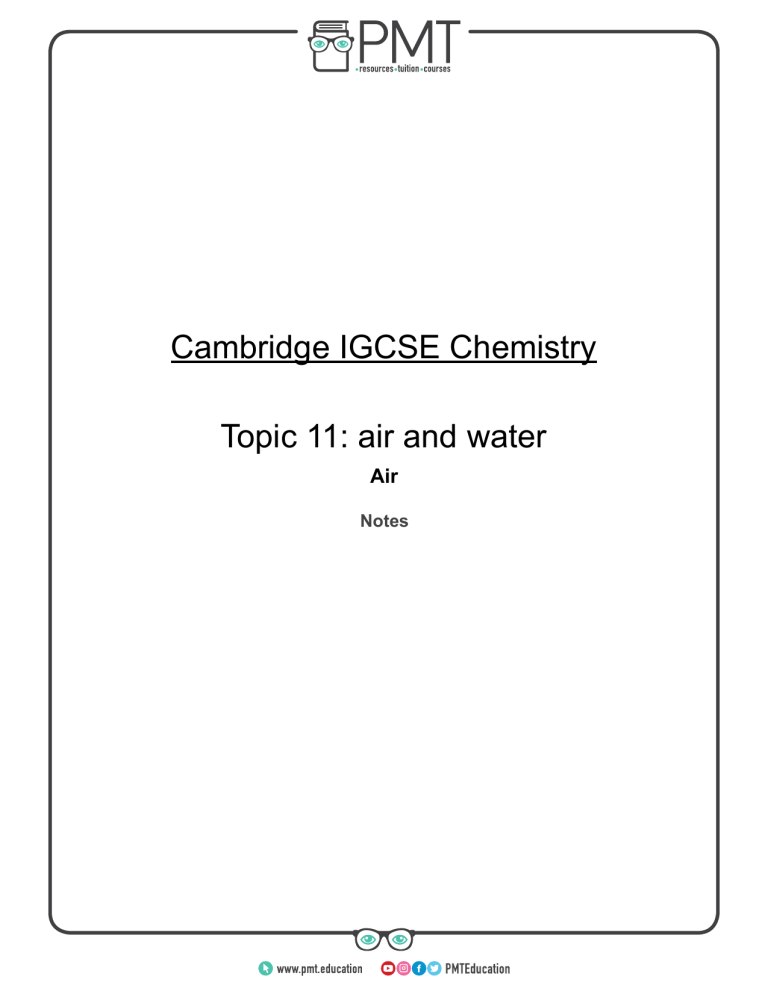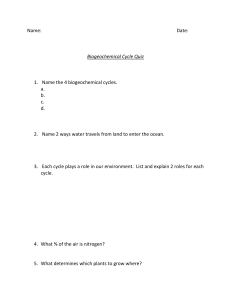
Cambridge IGCSE Chemistry Topic 11: air and water Air Notes www.pmt.education State the composition of clean, dry air as being approximately… ● 78% nitrogen ● 21% oxygen ● Rest is a mixture of noble gases and carbon dioxide (Extended only) Describe the separation of oxygen and nitrogen from liquid air by fractional distillation ● Fractional distillation of liquid air separates oxygen and nitrogen ● oxygen has a boiling point higher than that of nitrogen ○ air is liquefied (around -200°C) ○ fractional distillation column temperature is increased until nitrogen boils and rises to the top as a gas (around -196°C) ○ the nitrogen is collected and removed ○ the temperature is increased until oxygen boils and rises to the top as a gas (around -183°C) and oxygen is collected Name the common pollutants in the air as being… ● Carbon monoxide, sulfur dioxide, oxides of nitrogen and lead compounds State the source of each of these pollutants: ● Carbon monoxide – incomplete combustion of carbon-containing substances ● Sulfur dioxide – combustion of fossil fuels which contain sulfur compounds (leading to ‘acid rain’) ● Oxides of nitrogen – car engines ● Lead compounds – leaded petrol (Extended only) Describe and explain the presence of oxides of nitrogen in car engines and their catalytic removal ● Oxides of nitrogen are formed from the heat and pressure found in a car engine ● Catalytic converters are used to remove oxides of nitrogen ○ Carbon monoxide + nitrogen monoxide -> nitrogen + carbon dioxide ○ Nitrogen and carbon dioxide are relatively harmless gases compared to carbon and nitrogen monoxides www.pmt.education State the adverse effect of these common pollutants on buildings and on health and discuss why these pollutants are of global concern ● Carbon monoxide ○ Poisonous gas ■ Causes health problems – breathing difficulties, because it reduces the amount of oxygen that red blood cells can carry around the body ■ Too much carbon monoxide results in carbon monoxide poisoning, which can kill ● Sulfur dioxide ○ Forms acid rain ■ Kills plants and aquatic life ■ Erodes stonework ■ Corrodes metals ● Oxides of nitrogen ○ React with other pollutants, in sunlight, to form a photochemical smog, which causes breathing difficulties ○ Also forms acid rain ■ Kills plants and aquatic life ■ Erodes stonework ■ Corrodes metals ● Lead compounds ○ Lead is toxic ■ Causing health issues ● Petrol is used on a global scale, so these problems affect the whole world. These issues are serious – from damage of property to health issues, they need to be addressed globally State the conditions required for the rusting of iron ● When iron comes into contact with water and oxygen Describe and explain methods of rust prevention, specifically paint and other coatings to exclude oxygen ● To keep both oxygen and water away: ○ paint ○ cover in oil/grease ○ coat with plastic/another metal ● to keep oxygen away: ○ store in a vacuum container www.pmt.education (Extended only) Describe and explain sacrificial protection in terms of the reactivity series of metals and galvanising as a method of rust prevention ● Galvanising: a less reactive metal can be coated with a more reactive metal to prevent it from rusting ● e.g. iron and steel can be coated with zinc ● This works because the more reactive metal is oxidised by oxygen in the air (i.e. rusts), protecting the less reactive metal underneath www.pmt.education





